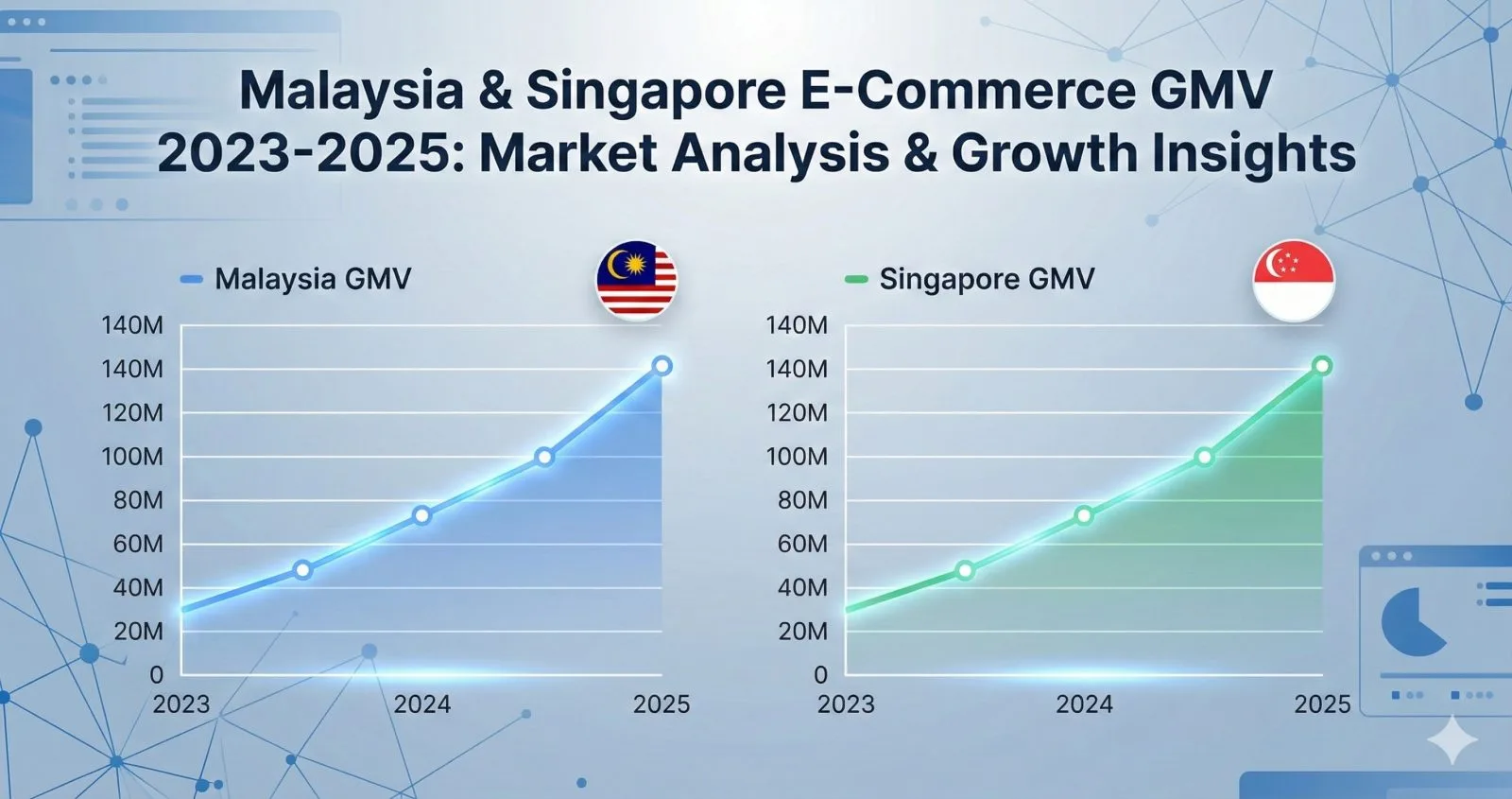Malaysia & Singapore E-Commerce GMV 2023-2025: Market Analysis & Growth Insights
Market Insights, Growth Drivers & Multichannel Strategies

Southeast Asia's digital commerce landscape continues its remarkable expansion, with Malaysia and Singapore playing pivotal roles in the region's growth story. As we progress through 2025, understanding the Gross Merchandise Value (GMV) trends in these markets has become essential for businesses planning their regional strategies.
This analysis examines e-commerce performance in Malaysia and Singapore from 2023 through 2025, explores the forces driving growth, and provides insights into operational strategies that enable businesses to thrive in these dynamic markets.
Understanding GMV: Why This Metric Matters
Gross Merchandise Value (GMV) represents the total value of merchandise sold through e-commerce platforms over a specific period. Unlike revenue, GMV includes all paid orders—even those later cancelled, returned, or refunded—providing a comprehensive view of transaction volume.
For businesses, GMV serves as a vital indicator of market size, consumer spending patterns, and digital commerce ecosystem health. Tracking these trends helps identify growth opportunities and inform strategic decisions.

Malaysia E-Commerce: Strong Growth Trajectory
The Numbers
Malaysia's e-commerce sector has demonstrated consistent growth, establishing itself as one of Southeast Asia's most dynamic digital markets:
2023
- E-commerce GMV: $13 billion USD
- Year-over-year growth: 12.2%
- Ranked third globally for e-commerce sales growth
2024
- E-commerce income: RM918.2 billion (first nine months)
- Quarterly peak: RM309.8 billion in Q2
- Market value: MYR48.5 billion ($10.6 billion)
2025 Forecast
- GMV projection: $16 billion USD
- Digital economy contribution: 23.5% of national GDP
- Expected CAGR: 8.5-11.3% through 2028
Key Growth Drivers
Government Support
The National E-Commerce Strategic Roadmap (NESR), now in its second phase (2021-2025), has successfully helped 1.51 million SMEs adopt e-commerce between 2016 and 2023. The initiative focuses on:
- Intensifying digital adoption across business segments
- Enhancing infrastructure and ecosystem development
- Strengthening consumer protection frameworks
Digital Infrastructure
With 80% internet penetration and 50% of the population actively shopping online, Malaysia offers strong digital foundations. Government investment in high-speed connectivity has eliminated traditional barriers to online commerce.
Marketplace Landscape
Three major platforms dominate Malaysia's e-commerce scene:
- Shopee: Commands 43% of traffic share
- Lazada: Holds 9% of traffic share, achieved profitability in July 2024
- TikTok Shop: Rapidly growing with 13.2% regional share, doubling Malaysian GMV year-over-year
Additional players include Zalora (fashion), PG Mall, Lelong.my, and emerging international platforms.
Payment Innovation
Malaysian consumers embrace diverse payment options:
- Alternative payment methods (GrabPay, ShopeePay): 35.7% market share
- Credit cards: 24.9% share
- Buy Now, Pay Later (BNPL): Rapidly growing among younger demographics
- Digital wallets: Strong adoption for seamless checkout
Consumer Behavior
Post-pandemic preferences have permanently shifted toward digital-first experiences, with 90% of consumers expecting delivery within one week. The market increasingly values seamless omnichannel experiences bridging online and offline touchpoints.
Regional Distribution
- Greater Kuala Lumpur: 42% of national GMV
- Penang and Johor: Significant contributions through manufacturing and proximity to Singapore
- East Malaysia: Growing at 8% as logistics improve
- Rural areas: Expanding through digital payment initiatives
Popular Categories
Electronics lead at $2.32 billion in 2023, followed by fashion at $2.01 billion. Home and living products, beauty and personal care, and furniture also perform strongly.

Singapore E-Commerce: Premium Market Dynamics
Market Overview
Singapore represents Southeast Asia's most mature e-commerce market, prioritizing quality and value over volume:
2023
- E-commerce GMV: $8 billion USD
- Global ranking: 34th
- E-commerce penetration: 58.8%
- Active shoppers: 3.51 million
- Average order value: $137.40 (highest in Southeast Asia)
2024
- Nearly 60% of internet users purchase online weekly
- Internet penetration: 96% (5.79 million users)
- Shopee monthly visitors: 13.21 million
2025 Projection
- Conservative GMV forecast: $10 billion USD
- Optimistic projections: Up to $25.3 billion by 2028
- Expected CAGR: 8.8-11% through 2028
Singapore's Unique Characteristics
Quality-First Approach
Unlike volume-driven markets, Singapore consumers prioritize:
- Product quality and authenticity
- Premium brands and exclusive offerings
- Reliable delivery and exceptional service
- Seamless digital experiences
This focus results in higher average order values and sustainable business models.
Technology Leadership
Singapore's Smart Nation initiative provides:
- 169.6% mobile penetration rate
- 95%+ 5G coverage since 2022
- Ultra-high-speed nationwide internet
- 90% digital payment adoption
Regional Hub Status
Singapore serves as Southeast Asia's e-commerce gateway:
- 45% of transactions are cross-border
- Primary sources: China (62%), United States, South Korea
- Home to Shopee and Lazada headquarters
- Strategic position for regional expansion
Competitive Landscape
- Shopee: 52% GMV share in 2023
- Lazada: 35% GMV share
- TikTok Shop: 5% GMV share and growing
- Qoo10: Strong fashion and lifestyle presence
Regulatory Framework
Singapore maintains comprehensive regulations ensuring:
- Strong consumer protection
- Robust cybersecurity standards
- Clear taxation policies
- Transparent data protection requirements
Southeast Asia Context: The Bigger Picture
Understanding Malaysia and Singapore requires viewing them within the regional ecosystem.
Regional Performance (2023)
Southeast Asian e-commerce reached $114.6 billion GMV, representing 15% year-over-year growth:
- Shopee: $55.1 billion (48% market share)
- Lazada: $18.8 billion
- Tokopedia: $16.3 billion
- TikTok Shop: $16.3 billion (nearly quadrupled from 2022)
Growth Patterns
- Vietnam: Fastest-growing at 52.9% YoY
- Thailand: Strong 34.1% YoY growth
- Indonesia: Largest market, steady growth
- Malaysia: Top three globally for sales growth
- Singapore: Highest quality metrics, strategic hub
2025 Outlook
- The region is projected to reach $186 billion GMV by 2025, with revenue growing at 1.7x the rate of GMV as platforms emphasize profitability.

The Operational Challenge: Managing Multichannel Complexity
As markets expand, businesses face increasingly complex operational demands. Successful retailers must now coordinate multiple marketplaces (Shopee, Lazada, TikTok Shop), owned webstores, social commerce channels, physical retail, and B2B platforms—all simultaneously.
Without unified systems, common challenges emerge: inventory discrepancies causing overselling, manual order processing creating delays, fragmented customer service information, difficult financial reconciliation, and limited scalability. These issues directly impact revenue through cancellations, increased operational costs, and customer churn.
The Solution: Unified Order Management
Modern e-commerce success requires integrated operational infrastructure. Order Management Systems (OMS) provide centralized platforms coordinating all multichannel retail aspects—from real-time inventory synchronization and centralized order processing to unified customer communication and advanced analytics.
Among the solutions available in Malaysia and Singapore, platforms like Sellercraft have established strong regional presence, offering deep marketplace integration, real-time syncing, and comprehensive tools that help businesses coordinate operations efficiently across channels.
Key Strategies for Success
- Embrace Multichannel Operations: Diversify across platforms while maintaining operational consistency through unified systems.
- Optimize for Mobile: With mobile dominating both markets, ensure mobile-optimized presentations, support mobile payments, and create mobile-first campaigns.
- Leverage Data: Make informed decisions through consolidated reporting, channel analysis, and inventory optimization based on sales velocity.
- Prioritize Customer Experience: Meet marketplace SLAs consistently, provide accurate stock information, ensure reliable delivery, and maintain professional communication.
- Prepare for Expansion: Use Singapore as a regional hub and Malaysia's proximity to neighboring markets for broader growth opportunities.
Future Outlook
Several trends will shape the continued evolution:
- Technology: AI personalization, augmented reality experiences, voice commerce, and sustainability focus.
- Market Dynamics: Platform expansion into financial services, intensifying competition from international players, and brands building direct-to-consumer channels.
- Infrastructure: Logistics innovation through autonomous delivery, 5G expansion enabling richer experiences, and warehouse automation transforming fulfillment operations.

Conclusion: Navigating Growth with the Right Foundation
Malaysia and Singapore's e-commerce markets present significant opportunities as they progress toward their 2025 targets. Malaysia's climb from $13 billion to $16 billion GMV and Singapore's expansion from $8 billion to $10 billion reflect the region's digital commerce momentum.
Success in these markets requires more than marketplace presence—it demands operational excellence. As competition intensifies and consumer expectations rise, integrated infrastructure becomes the differentiator between thriving businesses and struggling competitors.
Unified order management has evolved from optional efficiency tool to essential competitive requirement. Businesses coordinating multiple channels manually face inevitable scaling limitations and operational challenges.
The path forward involves:
- Strategic multichannel presence across key platforms
- Operational infrastructure enabling efficient coordination
- Data-driven decision making for continuous optimization
- Customer-centric focus meeting elevated expectations
- Scalable systems supporting sustainable growth
Whether you're exploring multichannel selling for the first time, optimizing established operations, or managing complex enterprise requirements, investing in robust operational infrastructure positions your business to capture opportunities in Southeast Asia's dynamic e-commerce landscape.
Taking the Next Step
For businesses ready to enhance their multichannel operations, several paths forward exist:
Evaluate Your Current State
- Assess existing operational challenges
- Identify bottlenecks limiting growth
- Calculate costs of manual processes
- Determine integration requirements
Research Available Solutions
- Compare OMS platforms serving the region
- Review marketplace integration capabilities
- Consider scalability and customization options
- Evaluate local support and expertise
Plan Your Implementation
- Define clear operational objectives
- Establish success metrics
- Allocate resources for transition
- Prepare team for new workflows
Consider Expert Guidance
Many businesses benefit from partnering with experienced providers who understand regional market dynamics. Platforms like Sellercraft offer not just technology but also sales enablement services, helping businesses optimize every aspect of their e-commerce operations.
For those interested in exploring comprehensive OMS solutions with deep Southeast Asian expertise, visiting Sellercraft provides information on platform capabilities, client success stories, and consultation options.
The future of e-commerce in Malaysia and Singapore offers tremendous potential. With the right operational foundation and strategic approach, your business can thrive in these exciting markets.
Have random questions?
Sellercraft offers market entry services designed to help global brands launch and scale their business in Malaysia or Singapore efficiently.